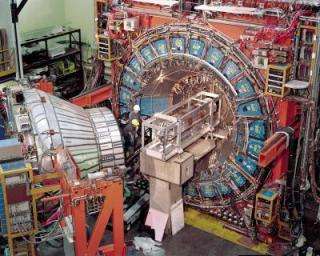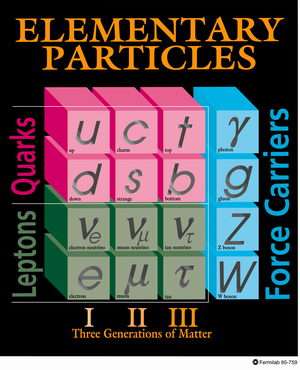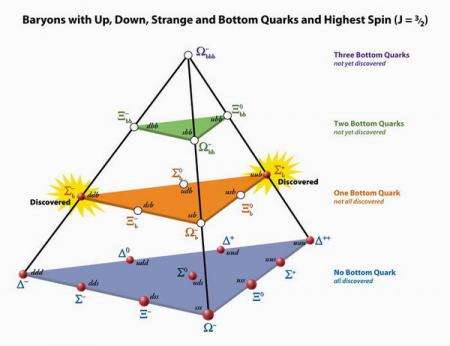The center of the upgraded CDF detector features a silicon vertex detector, installed in January 2001. The improved detector has taken data since March 2001. The vertex detector allows experimenters to record tracks of charged particles with utmost precision. Tracing the particle tracks back to their origin, scientists discover what processes take place at the core of proton-antiproton collisions. Credit: Fermilab
Scientists of the CDF collaboration at the Department of Energy's Fermi National Accelerator Laboratory announced today (October 23, 2006) the discovery of two rare types of particles, exotic relatives of the much more common proton and neutron.
"These particles, named Sigma-sub-b [Σb], are like rare jewels that we mined out of our data," said Jacobo Konigsberg, University of Florida, a spokesperson for the CDF collaboration. "Piece by piece, we are developing a better picture of how matter is built out of quarks. We learn more about the subatomic forces that hold quarks together and tear them apart. Our discovery helps complete the 'periodic table of baryons.'"
Baryons (derived from the Greek word "barys", meaning "heavy") are particles that contain three quarks, the most fundamental building blocks of matter. The CDF collaboration discovered two types of Sigma-sub-b particles, each one about six times heavier than a proton.
Six quarks--up, down, strange, charm, bottom and top--are the building blocks of matter. Protons and neutrons are made of up and down quarks, held together by the strong nuclear force. The CDF experiment has discovered exotic relatives of the proton and neutron, particles that include a bottom quark. Credit: Fermilab
There are six different types of quarks: up, down, strange, charm, bottom and top (u, d, s, c, b and t). The two types of baryons discovered by the CDF experiment are made of two up quarks and one bottom quark (u-u-b), and two down quarks and a bottom quark (d-d-b). For comparison, protons are u-u-d combinations, while neutrons are d-d-u. The new particles are extremely short-lived and decay within a tiny fraction of a second.
Utilizing Fermilab's Tevatron collider, the world's most powerful particle accelerator, physicists can recreate the conditions present in the early formation of the universe, reproducing the exotic matter that was abundant in the moments after the big bang. While the matter around us is comprised of only up and down quarks, exotic matter contains other quarks as well.
The Tevatron collider at Fermilab accelerates protons and antiprotons close to the speed of light and makes them collide. In the collisions, energy transforms into mass, according to Einstein's famous equation E=mc2. To beat the low odds of producing bottom quarks--which in turn transform into the Sigma-sub-b according to the laws of quantum physics--scientists take advantage of the billions of collisions produced by the Tevatron each second.
"It's amazing that scientists can build a particle accelerator that produces this many collisions, and equally amazing that the CDF collaboration was able to develop a particle detector that can measure them all," said CDF cospokesperson Rob Roser, of Fermilab. "We are confident that our data hold the secret to even more discoveries that we will find with time."
The CDF experiment identified 103 u-u-b particles, positively charged Sigma-sub-b particles (Σ+b), and 134 d-d-b particles, negatively charged Sigma-sub-b particles (Σ-b). In order to find this number of particles, scientists culled through more than 100 trillion high-energy proton-antiproton collisions produced by the Tevatron over the last five years.
Baryons are particles made of three quarks. The particles can exist in a ground state (J=1/2) and an excited state (J=3/2). The CDF experiment discovered the positively charged Sigma-sub-b and the negatively charged Sigma-sub-b in both spin configurations. The graphic shows the various three-quark combinations with J=3/2 that are possible using the three lightest quarks--up, down and strange--and the bottom quark. Past experiments discovered all of the baryons made of light quarks. The CDF discovery is the first observation of baryons with one bottom quark and spin J=3/2. Theory predicts four more such particles to exist. There are additional baryons involving the charm quark, which are not shown. The top quark, discovered at Fermilab in 1995, is too short-lived to become part of a baryon. Credit: Fermilab
In a scientific presentation on Friday, October 20, CDF physicist Petar Maksimovic, professor at Johns Hopkins University, presented the discovery to the particle physics community at Fermilab. He explained that the two types of Sigma-sub-b particles are produced in two different spin combinations, J=1/2 and J=3/2, representing a ground state and an excited state, as predicted by theory.
Quark theory predicts six different types of baryons with one bottom quark and spin J=3/2 (see graphic). The CDF experiment now accounts for two of these baryons.
Source: Fermi National Accelerator Laboratory


























